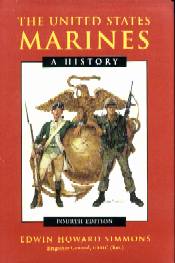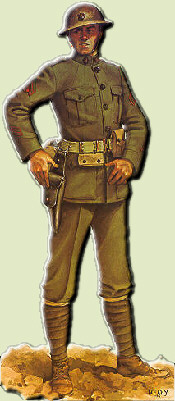A Special Contribution Courtesy of
BG Edwin Simmons and the Naval Institute Press
Maj. Gen. Cmdt. George Barnett was determined that a Marine expeditionary force would be on board the first convoy to sail for France. On 29 May, President Wilson approved the sending of a Marine regiment equipped as infantry. The stipulation was that the Marine regiment be organized and equipped according to the new wartime tables of organization developed by the Army. Marine regiments, such as they were, were small affairs of about eight hundred to a thousand men, a collection of numbered rifle companies of about 100 men each, with regiments and companies scattered all over the world. The companies would have to be brought up to a strength of about 250 men and organized into battalions and then into regiments, with such things as machinegun companies added. Barnett pulled in companies from such places as Pensacola, Norfolk, Cuba, Haiti, and the Dominican Republic, filled out the companies to war strength with recruits, and formed them up into the 5th Regiment of Marines, with battalions at Philadelphia Navy Yard and the tent camp at the new base at Quantico. Commanded by Charles Doyen, now a colonel, the regiment sailed on 14 June, much of it in the new Navy transport Henderson, and arrived at Saint Nazaire on 27 June 1917. Pershing parceled out the regiment as line of communication troops, mostly as military police. The 6th Marines under Albertus Catlin, now also a colonel, and the 6th Machine Gun Battalion came over in late 1917. The marines were brought together in early 1918 as the 4th Brigade, 2d U.S. Division, commanded by Doyen, promoted to brigadier general. It was a big brigade, 280 officers and 9,164 enlisted marines, as big as most of the under strength French and British divisions of the time. There was some winter training under the Chasseurs Alpins, whose disdain for the rifle except as a place to put the bayonet was in sharp conflict with Marine traditions.  US Marines at the Western FrontOn Saint Patrick's Day, the brigade went into a quiet bit of trenches southeast of Verdun. Four days later the Germans began their Amiens offensive. Foch, reconstituting his reserve, pulled out the French division and left the Marine brigade with a division front. Here they learned the realities of trench warfare: cooties, rats, wire parties, raids, and gas. The brigade was relieved on 9 May and along with the rest of the 2d Division moved to an assembly area northwest of Paris. Rumor was that they would follow the 1st U.S. Division into the attack at Cantigny. Pershing was mercilessly thinning the ranks of senior officers he considered too old or infirm for field command. Brigadier General Doyen was one of the casual ties. He was invalided home and replaced by a Pershing favorite, Army Brig. Gen. James Harbord. Harbord had been Pershing's chief of staff and he had gone from major to brigadier general in a year. Col. Buck Neville, now the commander of the 5th Marines and far senior to Harbord at the war's beginning, had every reason to think he should have been given command of the brigade. On Harbord's arrival, when Neville handed him a pair of Marine Corps emblems, it was half a greeting, half a challenge. Harbord promptly put them on his collar.  Marines of 6th MG Battalion, 4th Marine BrigadeThe Marines enjoyed an important advantage over their Army counter parts. Some 20 percent of the 5th Marines and 10 percent of the 6th Marines were "old-timers" (defined as someone with more than one year's service). The 9th Infantry and 23d Infantry regiments, their opposite numbers in the 3d Brigade of Infantry, had only about 5 percent. More significantly, the officer corps of the prewar Regular Army of some 130,000 men was spread very thin in a new American army that was expanding explosively to one million, two million, three million, four million men. The expansion of the Marine Corps was proportionately much less: from fifteen thousand to seventy-six thousand. From the grade of captain on up, the Marine Corps had a reservoir of experienced officers who had seen battle of a sort in such places as China, Panama, Nicaragua, Cuba, Haiti, and Santo Domingo. The same was true of the senior Marine NCOs.  Artist Georges Scott's Depiction of Belleau Wood[After the Armistice] the 4th Brigade of Marines marched on foot into Germany. A few days after the fighting was over they received new Browning machine guns and automatic rifles to replace their cranky Chauchats and clumsy Hotchkiss guns. Lejeune received a reprimand for the shabby appearance of his division from spit-and-polish inspectors who came down from GHQ. . . After an uneventful tour of duty along the Rhine in the Army of Occupation, the Marine brigade came home to Quantico in the summer of 1919. On 12 August there was a march past the White House and the next day at Quantico the brigade was demobilized and most of its members went home, taking with them their tin hats and gas masks as authorized souvenirs. Some thirty-two thousand marines had served in France. There had been 11,366 casualties of whom 2,459 were killed or were forever missing in action. Only twenty-five marines were taken prisoner. ("Surrendering wasn't popular," said Colonel Catlin.)  Recruiting Poster Inspired by Marine Victories |
|||||
|
Sources and thanks: Thanks to Susan Artigiani and Susan Todd Brooks at Naval Institute Press. Jerry Beach and Bill Anderson provided the illustrations. The text is copyrighted by General Simmons and is presented here with his permission and that of his publishers. MH |
To find other Doughboy Features visit our |
Michael E. Hanlon (medwardh@hotmail.com).

